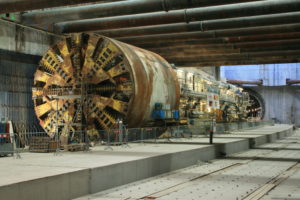In contrast to the cut-and-cover method, the New Austrian Tunnelling Method (NATM) is a mining technique that was first used in 1955 when building a tunnel for an Austrian hydropower plant.
The focus of the NATM in on taking advantage of the inherent geological strength available in the surrounding rock mass to stabilise the tunnel.
Firstly, the ground is drained using walls and secured using so-called steel plates, spears and steel tube screens. The tunnel is then sequentially excavated and supported metre by metre by applying shotcrete to steel arches and lattice girders.
Extensive geological knowledge is required for this method, and it is necessary to measure tension and pressure shifts in the rock on a continuous basis.
Today, the NATM is the most dominant tunnelling method used around the world.
Application
With the help of wells the soil is drained.
The subsoil is secured by steel sheeting or spiles.
The soil is excavated meter by meter and the tunnel is consolidated by applying shotcrete to arches and structural steel grids.
Advance securing
- Drill pipe with drill bit
- Pipe umbrella tube with integrated drill head
- Spit
- Plank
In the New Austrian Tunnelling Method, the ground material is removed step by step.
In order to secure the upcoming tunnel section before a new excavation, spiles, planks or pipe umbrella tubes are used.
These are inserted at the edge of the tunnel face (the tunnel section that has not yet been excavated) at a specific angle to the tunnel axis.
After demolition of the ground material, the tunnel wall is finally strengthened with steel grids and shotcrete.



